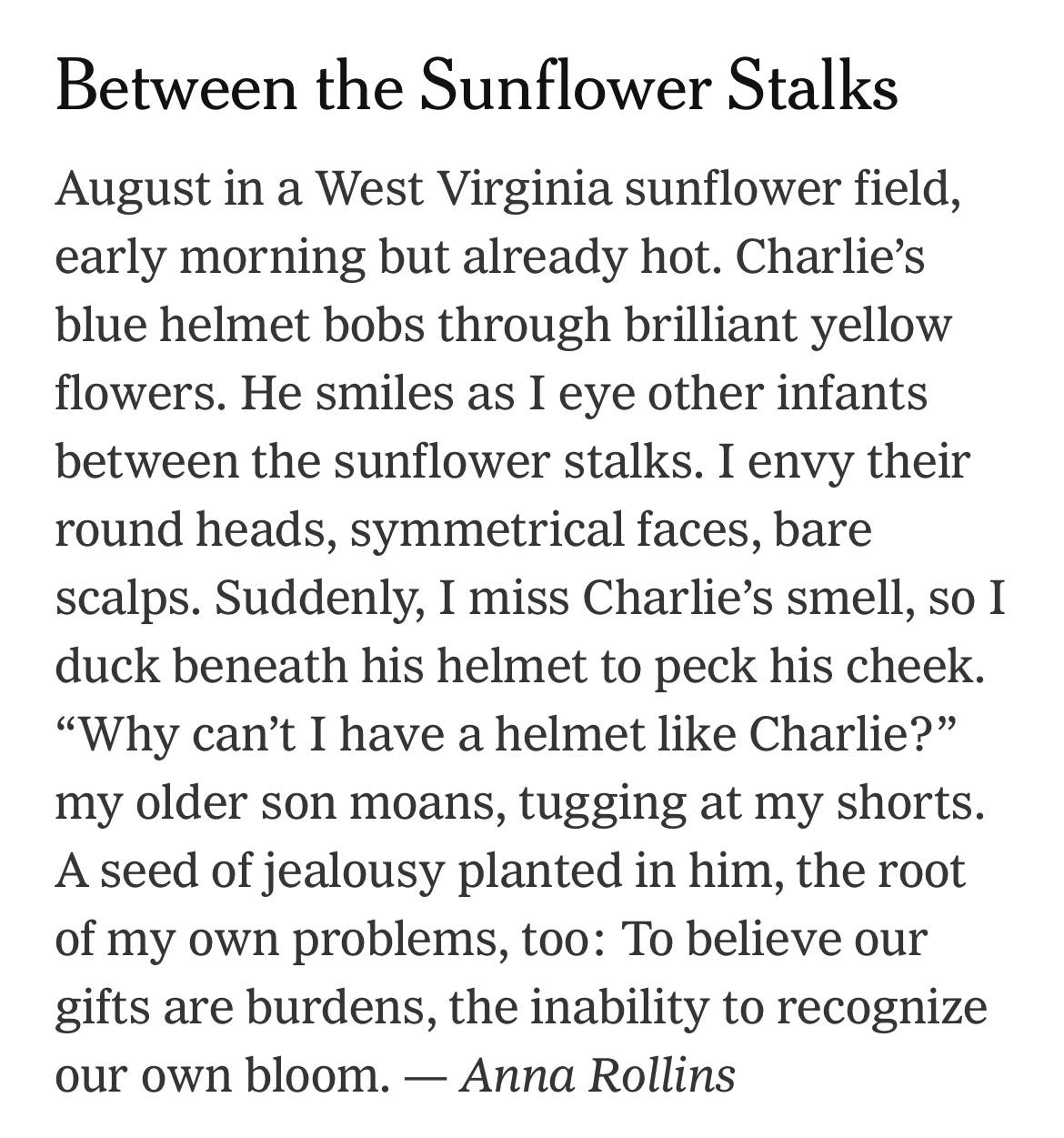Tiny Love Stories are 100-word micro memoirs included in the Modern Love column in the New York Times. Many Tiny Love Stories published in the column have appeared in an anthology, calendar, or podcast.
Are you interested in writing a Tiny Love Story? I’ve published two this past year. Here are my best tips for getting your yes.
1) Start with an eye-catching, emotionally charged photo
If you read through the Tiny Love Story column, you’ll notice there are two components to each submission: the story itself (words) and an accompanying photo (image).
I suggest you choose your image first. Scroll through your phone’s camera roll. Look for a strong photo. Choose one that is both aesthetically pleasing and that provokes some sort of emotional reaction from yourself.
Use that photo as a prompt for your Tiny Love Story.
2) Overwrite
Before you worry about the constraints of 100-words, freewrite about your chosen image. Set a timer for fifteen minutes. Force yourself to sit with the photo and write more than you think you can.
Describe the scene. Describe how you were feeling when the photo was taken. Describe how you feel about the photo now. Mention any other memories the scene brings up. Try to remember some dialogue that was spoken at the time the photo was captured.
3) Choose an extended metaphor
Now, review your freewrite. Circle any images you have mentioned.
Perhaps you noted the sun, the mountains, your baby boy, a rainbow. Circle those. See which image seems the most prominent and significant.
Not every Tiny Love Story includes extended metaphor – but many do. My first Tiny Love Story did. I intentionally chose to weave in the extended metaphor of a sunflower.
Here’s the story in full:
You’ll see that I used the extended metaphor of the sunflower with the following words/phrases: sunflower field, yellow flowers, sunflower stalks, seed, planted, root, bloom.
That’s a lot of flower language! And, when I could, I used flower language to talk about my emotional state, too.
Once you’ve chosen your prominent image, think about ways you could extend that language throughout your piece.
For instance, let’s say you’ve chosen the image of the sun. Very quickly, write down other words that you associate with the sun.
Here are my word associations:
Yellow, star, heat, light, rays, burning, fire, energy, core, incandescence, radiation.
Use a thesaurus, if you like. Or just Google your word to learn more about the way it’s spoken about.
4) Make something happen
Remember, you’re writing a story (a tiny one!). There should be some sort of narrative arc. There should be some sort of change.
This could be a physical change (you did not have a baby, and then you did). This could be an emotional change (you were unhappy, but now you’re not). But something needs to happen. You need some sort of tension to propel the reader to keep going, to make someone feel like your story was satisfying.
I love this Tiny Love Story by my friend, Megan Aronson:
You’ll see that the changes in this story mirror many marital vows. Worse to better. Sickness to health. And ultimately, hate to love.
There is, in other words, tension. Something changes. Something happens.
A Tiny Love Story, though about some form of love, is rarely pure happiness. Something hard is often juxtaposed with something beautiful.
Mine your own freewrite. Look for the hard. Look for the beautiful. Highlight the shift. And, based upon the genre conventions for this column, end your piece with hope.
5) Cut it out
Once you’ve chosen your main image and identified your story, now it’s time to cut. You only have 100 words, after all.
Before you eliminate scene, I suggest you cut commentary. Try to make your scenes articulate what you may be tempted to say yourself.
For instance, if you have a line that says, “it was a sweltering hot day, and we were all miserable,” you could cut that second clause. You don’t need to tell the reader you were miserable. This internal state is made clear by the adjective sweltering.
Other places to cut include prepositional phrases and adverbs. You often don’t need those. (I didn’t need to say often in the previous sentence).
Look for to-be verbs and see if you can swap them for action verbs.
Once you’ve gotten under 100 words, read your story aloud. Share it with a close friend (it’s a length appropriate for a text message, after all). Sit on it for a day or two. Revisit it.
Then, when you’re ready, go ahead and submit.
**
Thanks for reading my tips for writing a Tiny Love Story. Be sure to read my latest Tiny Love Story published last week at the New York Times.
Do you have friends who would be interested in these writing and publishing tips? Encourage them to subscribe to my Substack or follow me on Instagram at @annajrollins





Great tips, Anna. Thanks for sharing. While I've been published in the NYT I haven't had any success with the Tiny Love Story. I'll keep trying.
Was this your first big byline, Anna?